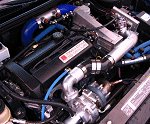

|
Street Class Unlimited Class
DOHC SOHC Ion Updated 1/05 For the most recent list of the fastest five cars click here. |
Wastegate 101by:TitanA turbo by itself does not know how to regulate boost levels. Basically, a turbo system is a positive feedback loop meaning that the engine's exhaust spins the turbo which, forces more air into the intake making more exhaust which, in turn spins the turbo even faster. Without a way to regulate boost levels the turbo would keep producing higher pressures until the engine exploded. This is where the wastegate comes into play. The wastegate attaches onto the turbo header before the turbo. When you begin accelerating exhaust gas pressure builds inside the manifold and is forced through the turbo. This pressure continues to increase as the turbo spins faster (remember the positive feedback loop). When the desired boost level is reached the wastegate opens and vents pressure from inside the manifold so the turbo won't spin any faster. So how does the wastegate work exactly?
Above is a diagram of a typical external wastegate. Inside the wastegate is a diaphragm which creates a seal, and a spring which holds the wastegate closed. Spring rates vary depending on the amount of boost you want to run, typically they are given in a "bar" value for example 1 bar would be 14.7psi. This would mean that in order to open the wastegate you would need to excerpt a greater pressure than the 14.7psi spring holding the wastegate closed. In order for the wastegate to work you must have the compressor reference port hooked up to the compressor side of the turbo, if you don't have this vacuum line attached than the boost pressure will not be limited to the set spring pressure; it will build unlimited boost pressure until your engine is destroyed. Normally pressure from a spooling turbo pushes against the diaphragm (though the vacuum line attached to the compressor reference port) which in turn pushes against the wastegate spring. When the pressure from the spooling turbo exceeds the spring pressure the wastegate's plunger opens releasing the excess pressure through the dump tube into the exhaust after the turbo or to open atmosphere. Typically, if you use the wastegate to control your boost levels you will experience a decrease in power and spool times. Why? Although the spring fully opens at its set spring pressure it tends to begin opening before reaching the set spring pressure. This "pre-opening" leaks boost pressure through the dump tube before max boost pressure is reached resulting in a decrease in power mostly toward the top end. This can be corrected by using a boost controller.
A manual boost controller will allow you to increase boost levels beyond what the wastegate spring is set. How does it work? Below is a diagram of a manual wastegate.
In order to run a manual boost controller we need to tee off of the vacuum line which runs from the turbo compressor housing to the compressor reference port. The manual boost controller works using a spring and check ball, by screwing the adjusting screw into the boost controller you put more pressure on the spring which reduces the amount of airflow through the boost controller and into the boost controller port. Less airflow means less pressure will be assisting the spring to keep the wastegate plunger shut. The pressure in the vacuum line going to the compressor reference port will equal the pressure the turbo is producing. A boost controller will allow you to direct some of that pressure to the top of the wastegate diaphragm creating two opposable forces. By adjusting the spring pressure of the boost controller you can vary the amount of boost that the turbo will make before opening the wastegate's plunger. If you want to run a higher boost level than the wastegate spring allows you will need a boost controller.
Without a line running from the compressor housing to the wastegate's compressor reference port boost pressures will keep increasing forever. This will quickly destroy your engine! Run a wastegate as close to the desired boost pressure as possible this will help the boost controller handle the pressure better. You can't reduce your desired boost pressure lower than the spring rate. |
|





